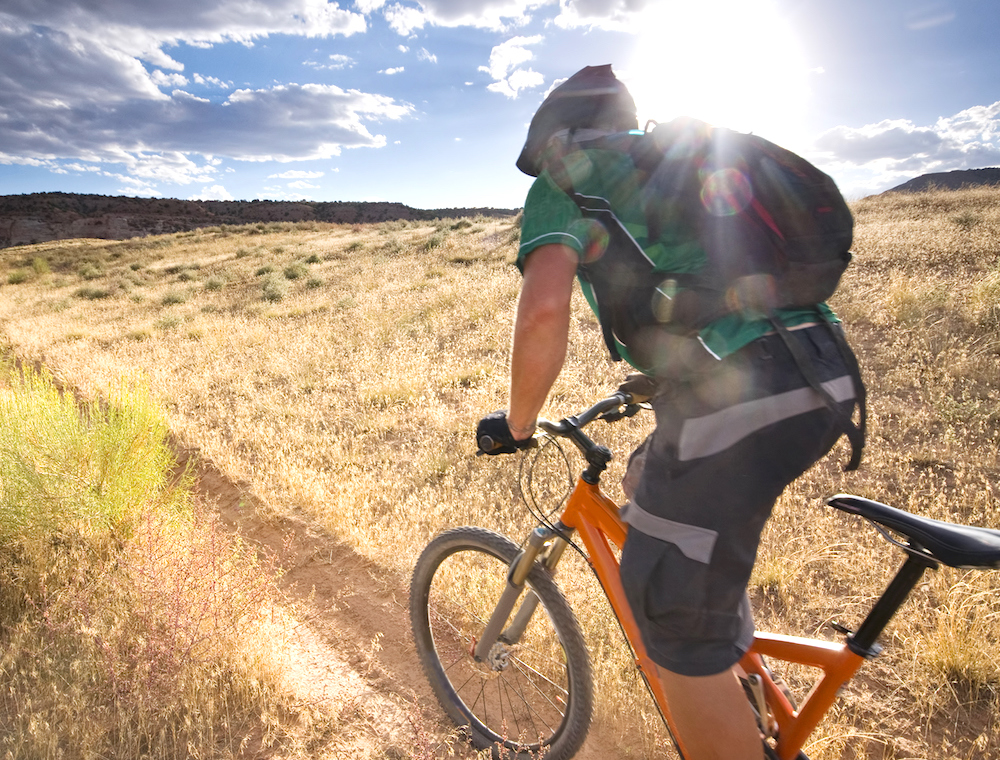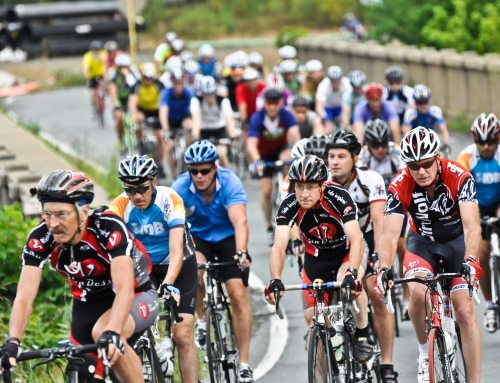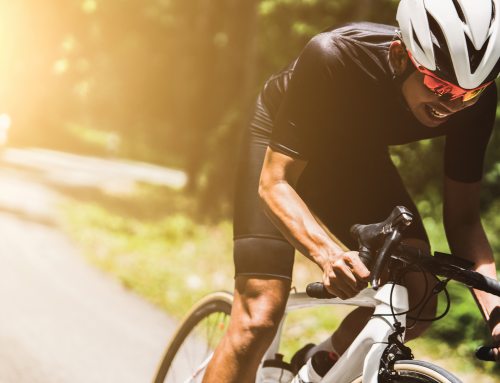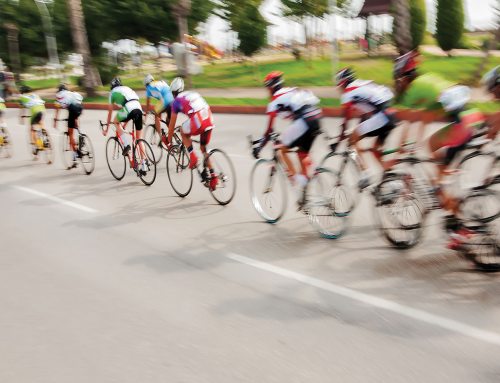More and more American cyclists are hitting the road as the sport gains in popularity. In fact, an estimated 80 million people in the U.S. use bicycles for commuting, recreation or sport. Whether riding as a commuter or a weekend warrior, cycling is a great form of exercise. Biking provides health benefits that include improved cardiovascular function and heart health, increased stamina and muscle tone – and it blasts calories.
But it is not unlikely for enthusiasts to experience pain and injuries from cycling.
The most common injuries
Knee pain – Pain in the knee as a result of overuse is a common complaint among cyclists. Common knee overuse injuries include cyclist’s knee, tendinitis and iliotibial band syndrome.
“Probably the most prevalent injury we see in cycling is iliotibial band (IT band) syndrome,” said Dr. Mark Schweppe, an orthopedic surgery specialist at Novant Health Orthopedics and Sports Medicine Winston-Salem. “The iliotibial band is a tendon that originates at the hip and inserts at the knee. It is a common cause of hip and knee pain, specifically on the outside of the knee.”
“Tendonitis can also cause pain in the front of the knee from overuse of the quadriceps muscle and patellar tendon,” he added.
Head injuries – About 75 percent of all bicyclists who die riding each year die as a result of head injuries. Wearing a helmet can reduce the risk of sustaining a head injury by 85 percent.
“Helmets are extremely important for cyclists of all ages and ability level,” Schweppe said.
According to the Centers for Disease Control and Prevention, among the millions of Americans who ride bicycles, nearly half of them do so without wearing a helmet. The agency reported that in 2010, 800 bicyclists died while riding in the U.S. and an estimated 515,000 sustained bicycle-related injuries that required emergency room care.
Even expert riders can get into crashes, so wear a helmet.
“From our children to professional cyclists, no one should cycle without a helmet,” Schweppe said.
Neck and back pain – Holding a position for too long while on a ride can cause back and neck pain in cyclists. Stretching and shrugging the shoulders can sometimes help relieve some of the stiffness, but it won’t eliminate the problem.
“Cyclists often experience both neck and back pain and this is often due with not having a proper fit on a bike,” Schweppe said.
“Having a bike fit correctly is very important and one of the keys to injury prevention,” Schweppe added. “The frame has to be the right size relative to the rider. The height of the seat needs to be adjusted to fit the rider, as do the handle bars and pedals.”
Have your bike fitted to your exact size by a professional bike shop so the handle bars and seat are set to your specifications. If handlebars are set too low, for instance, riders may have to strain to reach the bars, causing unneeded stress on the neck and back.
Stretching can help as well. Tightness of the hamstrings or hip flexors can cause riders to compensate by rounding or arching their backs. Stretching these muscles before and after a ride can help with flexibility and the maintenance of proper form.
“It’s important to warm up and stretch before and after a ride,” said Bobbi Cave, athletic training coordinator with Novant Health Rehabilitation Center in Winston-Salem. “If you have a cold muscle and you hop onto a bike, you’re basically stretching that muscle past its capacity which will lead to sprains and strains.”
Hand and wrist pain – Numbness and pain in the hands, wrists and forearms is a common complaint among cyclists as well. By holding the handlebar in the same position for a long time, gripping it too tightly or leaning too far over the front wheel, cyclists can strain the nerve that runs the length of the forearm.
“Numbness or tingling in a rider’s hands is a common occurrence,” Schweppe said. “It can be related to the posture while riding.”
Schweppe said padded gloves can sometimes help as a quick fix, but he adds that often the pain relates to a poor bicycle fit.
Other suggestions to help reduce the tingling sensation include moving the hands around the handlebar to prevent numbness and pain. Road bike handlebars offer various positions where a cyclist can grip their hands: on top below and on the sides of the bar. If you begin to feel tingling while riding, your body is telling you to shift your position.
The American Orthopaedic Society for Sports Medicine (AOSSM) recommends riding with elbows slightly bent for added shock absorption when hitting road bumps.
Two common wrist overuse injuries associated with bicycling are cyclist’s palsy and carpal tunnel syndrome. The society says that alternating the pressure from the inside to the outside of the palms and keeping wrists above the handlebar will help prevent these conditions.
Groin and backside pain – Riders who spend long periods in the saddle can experience numbness or pain in the genital area and on the backside. Schweppe said the condition is referred to as “saddle anesthesia.”
“It’s often the result of riding on an uncomfortable seat,” he said. He recommended switching to bike seats with additional padding and riding with padded bike shorts which provide for more comfort.
Tingling in the feet – Numbness in the foot is a common complaint among riders. This can be caused by something as simple as ill-fitting cleats, or shoes that are too tight. AOSSM says the numbness can be due to exertional compartment syndrome, a condition caused by increased pressure in the lower leg and the compression of nerves.
Tips to prevent cycling injuries
- To minimize pain and injury from cycling, get your bike properly fitted.
- Make sure your seat is level because if it is tilted either upward or downward, it will create extra pressure on knees, arms, hands and back leading to pain and possible injury.
- Adjust the height of the seat to fit your height. When standing next to the bike, the seat should sit at about hip level of the rider. Once on the bike with one pedal at the lowest level (6 o’clock position) and the other pedal horizontal (3 o’clock position), the rider should have one leg fully extended at the lowest level and the other leg flexed at 30 degrees.
- Special shoe implants and adjustments in cleat positions for pedals may help prevent knee pain.
“These preventive measures are really for cyclists of all ages and abilities,” Schweppe said. “For the weekend warrior, it’s just as important to have appropriately fitting equipment as it is for the competitive cyclist.”
Cave said she believes that cyclists would benefit from sports conditioning programs, too.
“I would recommend additional training beyond cycling because athletes are so focused on their sport that they don’t cross-train properly, and that’s when we see overuse injuries,” she said.
There are a number of exercises she suggests to avoid injury. “We focus on core strengthening, lower back exercises and stretching,” she said. “We also want to work on range of motion, agility and balance to try to work the ankles and the knees, all the way up the kinetic chain.”
When to seek treatment from a medical provider
Sometimes despite preventive measures, athletes will need to seek help from a medical provider for their pains.
“At any point that an ache and pain becomes persistent and doesn’t respond to conservative treatment such as rest, ice, compression and elevation, then it would be reasonable to seek out professional care,” Schweppe said.
“Any ailments that are associated with swelling or what we call mechanical symptoms, such as locking, popping, clicking, catching or giving way should be evaluated by a provider as well,” he said.
Tips for Proper Form
- Keep the ball of the foot over the middle of the pedal.
- Sit forward on the bike so knee is in line with the ankle and foot, but make sure the knee doesn’t protrude past the toes when the knee is bent.
- Align the knee, leg and foot to focus on keeping the foot on pedal easily. Minimize the effort needed to push on pedal.
- Sit up tall, keeping the back straight, and bend forward at the hips, rather than the midback, when reaching arms to handlebars.
- Do not place excessive upper body weight on the arms, wrist and hands when leaning on handlebars.
- Keep a slight bend in the elbows and keep the upper body relaxed.
# # #
Learn about sports medicine services offered by Novant Health at NovantHealth.org/sportsmedicine.







